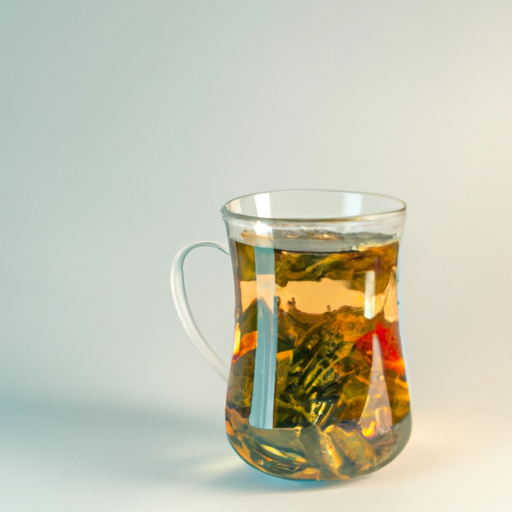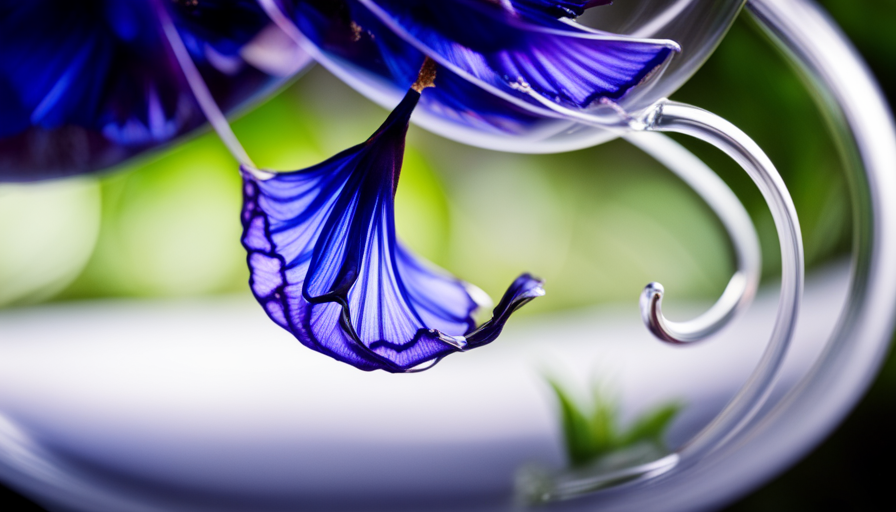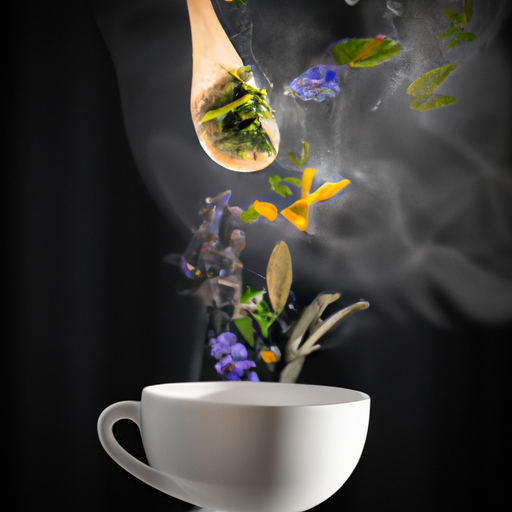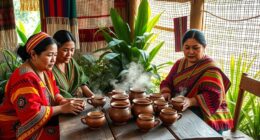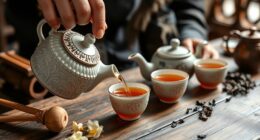Did you realize that more than 80% of the global population drinks tea every day? It’s no surprise that tea is one of the most beloved beverages worldwide.
And while there are countless varieties of tea available on the market, there’s something special about brewing your own herbal tea using dried leaves that you’ve harvested and dried yourself. Not only does it give you a sense of satisfaction, but it also allows you to control the quality and flavor of your tea.
In this article, I will guide you through the process of drying your own herbal tea leaves, from choosing the right herbs to harvesting and properly drying them. By the end of this article, you’ll be able to enjoy a cup of homemade herbal tea that is not only delicious but also packed with all the natural goodness of the herbs you’ve grown.
Key Takeaways
- Harvest herbs at their peak flavor and potency, selecting vibrant and blemish-free leaves while avoiding herbs sprayed with pesticides.
- Properly wash and dry herbs by gently rinsing them under cold water, patting them dry, and removing excess moisture.
- Choose air drying over oven drying to retain natural oils and flavors, hanging herb bundles upside down in a cool, well-ventilated area away from sunlight.
- Store dried tea leaves in airtight containers, such as glass jars or resealable bags, to maintain freshness and flavors for up to 6 months.
Choose the Right Herbs for Drying
Now let’s talk about how to choose the herbs that’ll make your taste buds tingle with anticipation. When it comes to selecting fresh herbs for drying, there are a few tips to keep in mind.
First, choose herbs that are at their peak flavor and aroma. Look for leaves that are vibrant in color and free from any blemishes or signs of wilting. Avoid using herbs that’ve been sprayed with pesticides or other chemicals, as these can alter the taste of your tea.
Additionally, be sure to harvest the herbs at the right time, when the oils and flavors are concentrated. Common mistakes to avoid when drying herbal tea leaves include using old or wilted herbs, as well as over-drying them, which can result in a loss of flavor.
By selecting the freshest herbs and avoiding these pitfalls, you’ll be well on your way to brewing a delicious cup of homemade herbal tea.
Now, let’s move on to the next step: harvesting the herbs at the right time.
Harvest the Herbs at the Right Time
When gathering the herbs, make sure you pick them at the optimal time for maximum flavor and potency. The best time to harvest herbs for drying is in the morning, after the dew has dried but before the heat of the day. This is when the essential oils in the herbs are at their highest concentration, resulting in a more flavorful and aromatic tea.
Different herbs have different ideal harvesting times, so it’s important to research and understand each herb’s specific needs. For example, mint should be harvested just before it flowers, while chamomile flowers are best picked when they’re fully open.
Once you’ve harvested your herbs at the right time, you can move on to the next step of wash and dry the herbs properly, ensuring that they retain their quality and flavor throughout the drying process.
Wash and Dry the Herbs Properly
To ensure the herbs maintain their quality and flavor, it’s crucial to properly wash and dry them. Proper herb washing techniques are essential to remove any dirt, insects, or pesticides that may be present. Start by gently rinsing the herbs under cold running water to remove any surface debris. Be careful not to bruise or damage the leaves. Next, pat them dry with a clean towel or use a salad spinner to remove excess moisture. Once the herbs are clean, it’s time to dry them properly. There are two main methods: air drying and oven drying. Air drying is the preferred method as it allows the herbs to retain more of their natural oils and flavors. In contrast, oven drying may result in a loss of some of the herbs’ aromatic qualities. Transitioning into the subsequent section about the ‘air drying method,’ we will explore the best techniques to air dry your herbal tea leaves.
Air Drying Method
One great way to preserve the natural oils and flavors of your favorite herbs is by using the air drying method. Air drying is a gentle and traditional method that allows the herbs to slowly release their moisture while retaining their aromatic properties.
Unlike other methods, such as oven drying or using a dehydrator, air drying helps maintain the integrity of the herbs and avoids the risk of overheating or losing essential oils. To successfully air dry your herbal tea leaves, start by harvesting them when they’re at their peak flavor. Remove any damaged or wilted leaves and tie them into small bundles using twine.
Hang the bundles upside down in a cool, well-ventilated area away from direct sunlight. This method can take anywhere from a few days to a few weeks, depending on the herb and humidity level. Once the leaves are completely dry and crumble easily, they’re ready to be stored or used in your favorite tea blends.
Moving on to the next method, the oven drying method, provides a quicker alternative for those who’re short on time.
Oven Drying Method
If you’re looking for a quicker option, you can try using the oven drying method to preserve the rich flavors and aromas of your favorite herbs. This alternative drying method offers several benefits over air drying. First, it is much faster, allowing you to enjoy your homemade herbal tea sooner. Second, oven drying helps to retain more of the herb’s natural oils, ensuring a more potent and flavorful cup of tea. Lastly, it can be done year-round, regardless of the weather conditions outside. To get started, simply preheat your oven to the lowest temperature setting. Spread your freshly harvested herbs in a single layer on a baking sheet and place in the oven for about 1-2 hours, or until the leaves are crispy and crumble easily. Once your tea leaves are fully dried, you can move on to the next step of storing them in an airtight container.
Store the Dried Tea Leaves
When storing the dried tea leaves, it’s important to keep them in an airtight container to maintain their freshness and preserve their flavors for up to six months.
There are various packaging options available for storing dried tea leaves, such as glass jars or resealable bags. Glass jars are an excellent choice as they’re non-reactive and don’t absorb odors, ensuring the tea leaves retain their natural aromas. Resealable bags are also convenient and can be easily labeled for identification.
Additionally, consider getting creative with the use of dried tea leaves in recipes. They can be infused in oils or added to soups, stews, or even baked goods for a unique flavor experience.
Now that the tea leaves are properly stored, let’s move on to the next section and learn how to brew and enjoy your homemade herbal tea.
Brew and Enjoy Your Homemade Herbal Tea
Now that you’ve stored your dried tea leaves, it’s time to brew and savor the delightful flavors of your homemade herbal infusion. To fully appreciate the benefits of homemade herbal tea, follow these tips for enhancing its flavor:
-
Start by boiling water in a kettle or pot.
-
Once the water reaches the desired temperature, pour it over a teaspoon of your dried tea leaves.
-
Allow the tea to steep for 3-5 minutes, depending on your taste preferences.
-
Strain the tea into a cup or mug to remove any loose leaves.
-
To enhance the flavor, consider adding a slice of lemon or a teaspoon of honey.
-
Take a moment to inhale the soothing aroma before taking your first sip.
-
Savor the delicate flavors and enjoy the calming effects of your homemade herbal tea.
By following these steps, you can create a delicious and refreshing cup of herbal tea that not only tastes amazing but also provides numerous health benefits.
So sit back, relax, and indulge in the goodness of your own homemade creation.
Frequently Asked Questions
Can I use any type of herb to make herbal tea leaves?
Yes, you can use a variety of herbs to make herbal tea leaves. Some popular options include chamomile, mint, lavender, and lemon balm. When harvesting herbs for tea, it’s best to choose leaves that are fully grown and free from pesticides.
How do I know when my herbs are ready to be harvested for drying?
When my herbs are ready to be harvested for drying, I look for signs of optimal herb harvesting such as vibrant color, strong aroma, and fully developed leaves. Best practices for drying herbs include air drying or using a dehydrator.
Do I need to wash my herbs before drying them?
No, washing herbs with soap can remove their natural oils and flavors. Instead, use alternative methods like gently rinsing with water or using a colander. This ensures the herbs retain their aromatic qualities when drying.
Can I use a dehydrator to dry my herbs instead of the air drying or oven drying methods?
Yes, you can use a dehydrator to dry herbs. It is a convenient method that allows for faster drying times and retains more of the herbs’ flavors. However, it may require additional equipment and can be more expensive than other drying methods.
How should I store my dried tea leaves to ensure freshness and flavor?
To ensure freshness and preserve aroma, store your dried tea leaves in an airtight container away from light, heat, and moisture. Remember the adage "out of sight, out of mind" when storing your precious tea leaves.
Conclusion
In conclusion, drying your own herbal tea leaves is a rewarding and worthwhile endeavor. By following the right steps and methods, you can ensure the highest quality of tea for you to enjoy.
Remember, the key is to choose the right herbs, harvest them at the right time, and properly wash and dry them. Whether you prefer the air drying or oven drying method, the end result will be aromatic and flavorful tea leaves that will invigorate your senses.
So go ahead, take the leap and embark on this herbal tea adventure – your taste buds will thank you!

